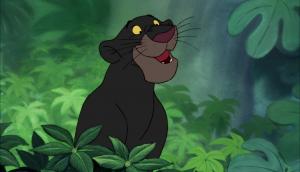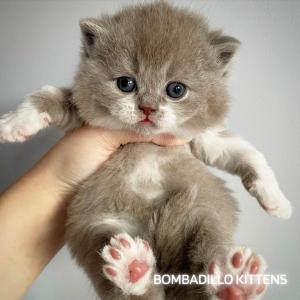Discover the variety of British Shorthair colours and patterns available
The British Shorthair is Britain’s favourite cat, and it is easy to see why: its big cobby body, loving but often quirky temperament and array of British Shorthair colours and patterns mean there is a British Shorthair for everyone!
Some British Shorthair colours are incredibly well known, but the British Shorthair comes in a myriad of wonderful colours and patterns, and new colours and patterns are being introduced all the time.
British Shorthair Colours
There is a huge variety of British Shorthair colours.....

- The Black British Shorthair: A good black British Shorthair is a true beauty - rich amber eyes staring out at you from a deeply pigmented black background always remind me of Bagheera, the black panther from the Jungle Book. The black British Shorthair is a striking cat, of unusual beauty.
A Bombadillo black bicolour British Shorthair kitten at just two weeks old:
- The British Blue: Blue is the most well known colour of all of the British Shorthair colours. It is a rather misleading description, because blue is in fact grey! It is easy to see why this is such a popular colour, with its wonderful muted grey tones, the British Blue is an instantly recognisable beauty. All blue cats are actually genetically black cats with an additional dilution gene. The dilution gene reduces the amount of pigment in the fur, which creates the blue/grey appearance. The blue remains the most popular of the British Shorthair colours. Read more about the British Blue.
- The Chocolate British Shorthair: A deep, rich chocolate colour is incredibly unusual and firm favourite with many people.
- The Lilac British Shorthair: A very unusual and pretty colour, lilac is a warmer grey. Lilac is actually a chocolate cat with the dilution gene, which reduces the pigment in the fur and makes the chocolate appear as lilac.
- The Cinnamon British Shorthair: A relatively new colour in the British Shorthair, the cinnamon is similar to chocolate but with a warmer, more ginger tone.
- The Fawn British Shorthair: Fawn is cinnamon with the dilution gene, making the pigment less concentrated and creating a very soft fawn colour. Fawn is very similar to lilac but a little softer and more muted.
- The Red British Shorthair: Whilst all of the other colours come from the black gene, red and cream, its diluted colour, are separate. All red cats will have some sort of tabby markings visible but the show cat aims to have as little visible tabby markings as possible. A rich, deep red is the most desirable colour on the show bench, but colour can vary from a pale ginger right through to a deep red. All red and cream cats have faint tabby patterns, but breeders aim for a cat with no visible markings at all.
- The Cream British Shorthair: A good cream British Shorthair should be a lovely pale cream, with no hint of ginger. Cream is the red gene with a dilution gene, so it is hard to achieve beautiful cream cats without the ginger hues.
- The White British Shorthair: The white gene is an additional gene that lays on top of the other genes, and has the effect of masking the colour of the cat, making it appear white. All white cats are, in fact, coloured cats but with the White gene.
British Shorthair Patterns
- Selfs: the term 'selfs' is used to describe any British Shorthair that is one solid colour, like the images above.
- Torties: Only female British Shorthairs can be torties, because the tortie gene is sex-linked. A tortie cat has one gene for black and another gene for red and both of them are visible in the coat. Black torties are black and red, blue torties blue and cream, chocolate torties are chocolate and red, lilac torties are lilac and cream, cinnamon torties are cinnamon and red, fawn torties are fawn and cream. The ideal tortie should have a fine intermingling of the two different colours throughout their coat, creating a finely dappled effect.
- Bicolours: Bicolour British Shorthairs are striking cats. They can come in any of the colour varieties, and have the addition of white markings, which are usually on their face, tummies and feet, but can appear anywhere on their bodies. They can be less than 50% white, or more than 50% white, depending on their genetic make up. The white spotting gene is different from the White gene. The white spotting gene prevents the pigment from descending over the entire body when the kitten is still in the womb. Read more about the bicolour British Shorthair cat.

- Calicos/tri-colours: These cats are basically tortie bicolours. The white spotting gene has an effect on the tortie pattern, making it appear in patches of colour rather than fine brindling throughout the coat. Below is a picture of mini-Patch, a lilac calico Bombadillo home-bred girl. She has patches of lilac and cream, with a white bicolour pattern on top. Discover the calico British Shorthair cat here.

- Colourpoints: Colourpoints can come in every possible British Shorthair colour variety. The colourpoint gene prevents the development of colour on the warmer parts of the cat, and the effect of this is that the extremities of the cat are darker in colour than the body. Below is a blue bicolour colourpoint:
- Tabbies: All cats are in fact tabbies, but there is a gene that hides the tabby patterns. Tabby cats do not have this additional gene. British Shorhair Tabbies come in wide array of colours including Silver Tabbies, Golden Tabbies, Blue Tabbies, Lilac Tabbies, Cinnamon Tabbies and Fawn Tabbies. Tabby cats can also be colourpoints and bicolours as well.
- The Silver Tabby is a very popular British Shorthair cat. They are black tabby cats that have the silver gene, which makes the background colour silver instead of a warmer tone. Their markings are striking, in any tabby variety.
- There are three main tabby varieties: mackerel, classic and spotted. Mackerel is stripey like a tiger, classic is marbled and spotted is obviously spotty!
British Shorthair colours: a classic Silver Tabby British Shorthair
A silver mackerel tabby British Shorthair kitten, at just 16 days old (he is the kitten of the cat in the photo above)
A bicolour silver tabby:
As we said, tabbies can come in many different colours and varieties....here is a very unusual blue-golden mackerel tabby. His subtle golden-blue tabby markings are exceptionally pretty and highly unusual. (Please be aware, this photograph was stolen by scammers to try to sell sub-standard kittens on Pets4Homes! Be aware - scammers are unfortunately everywhere)
Read more about these very unusual blue tabby British Shorthairs.
One of the many wonderful things about the British Shorthair cat is the wide variety of colours, patterns and markings that are available. Whilst the traditional and typical colour everyone thinks of is the British Blue, the possibilities are almost limitless with this wonderful breed of cat.
Find us on facebook, Instagram, YouTube and Twitter for more kitten photos!
Read more...
- British Shorthair eye colour
- the Cinnamon British Shorthair
- why all our kittens are GCCF registered
- the best cat trees
British Shorthair kittens available...
- Find out whether we have any kittens available
All of the images on this page are our own cats and kittens and all images are copyrighted. For more information, have a look through the rest of our articles...happy exploring!
We are expert British Shorthair breeders. We specialise in the more magical and unusual British Shorthair colours and patterns, but we do also get some of the more classic colours as well.